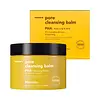What's inside
What's inside
 Key Ingredients
Key Ingredients

 Benefits
Benefits

 Concerns
Concerns

 Ingredients Side-by-side
Ingredients Side-by-side

Ethylhexyl Palmitate
EmollientCetyl Ethylhexanoate
EmollientSorbeth-30 Tetraoleate
EmulsifyingPolyethylene
AbrasiveHelianthus Annuus Seed Oil
EmollientC13-15 Alkane
SolventTrihydroxystearin
Skin ConditioningCitrus Aurantium Dulcis Peel Oil
MaskingLavandula Angustifolia Oil
MaskingTocopherol
AntioxidantCitrus Aurantium Bergamia Fruit Oil
MaskingCamellia Japonica Seed Oil
EmollientOenothera Biennis Oil
EmollientOlea Europaea Fruit Oil
MaskingPrunus Armeniaca Kernel Oil
MaskingSimmondsia Chinensis Seed Oil
EmollientGluconolactone
Skin ConditioningEthylhexyl Palmitate, Cetyl Ethylhexanoate, Sorbeth-30 Tetraoleate, Polyethylene, Helianthus Annuus Seed Oil, C13-15 Alkane, Trihydroxystearin, Citrus Aurantium Dulcis Peel Oil, Lavandula Angustifolia Oil, Tocopherol, Citrus Aurantium Bergamia Fruit Oil, Camellia Japonica Seed Oil, Oenothera Biennis Oil, Olea Europaea Fruit Oil, Prunus Armeniaca Kernel Oil, Simmondsia Chinensis Seed Oil, Gluconolactone
Caprylic/Capric Triglyceride
MaskingGlycerin
HumectantWater
Skin ConditioningDicaprylyl Carbonate
EmollientBorago Officinalis Seed Oil
EmollientCitrullus Lanatus Seed Oil
EmollientMoringa Oleifera Seed Oil
EmollientSucrose Laurate
EmollientMethylpropanediol
SolventSucrose Stearate
EmollientCitrus Aurantium Dulcis Peel Oil Expressed
PerfumingCaprylyl Glycol
EmollientCupressus Sempervirens Oil
MaskingPhenoxyethanol
PreservativeCellulose Gum
Emulsion StabilisingCitrus Aurantifolia Oil
CleansingCitrus Aurantium Bergamia Peel Oil
Juniperus Mexicana Oil
MaskingAllantoin
Skin ConditioningLavandula Angustifolia Oil
MaskingLavandula Hybrida Oil
EmollientLitsea Cubeba Fruit Oil
MaskingPelargonium Graveolens Flower Oil
MaskingPogostemon Cablin Leaf Oil
MaskingThuja Occidentalis Leaf Oil
MaskingAlgin
MaskingSucrose Palmitate
EmollientCentella Asiatica Extract
CleansingFerula Galbaniflua Resin Oil
AntimicrobialMaltodextrin
AbsorbentTocopherol
AntioxidantHydrolyzed Gardenia Florida Extract
AntioxidantGardenia Jasminoides Fruit Extract
Cosmetic ColorantLimonene
PerfumingLinalool
PerfumingCaprylic/Capric Triglyceride, Glycerin, Water, Dicaprylyl Carbonate, Borago Officinalis Seed Oil, Citrullus Lanatus Seed Oil, Moringa Oleifera Seed Oil, Sucrose Laurate, Methylpropanediol, Sucrose Stearate, Citrus Aurantium Dulcis Peel Oil Expressed, Caprylyl Glycol, Cupressus Sempervirens Oil, Phenoxyethanol, Cellulose Gum, Citrus Aurantifolia Oil, Citrus Aurantium Bergamia Peel Oil, Juniperus Mexicana Oil, Allantoin, Lavandula Angustifolia Oil, Lavandula Hybrida Oil, Litsea Cubeba Fruit Oil, Pelargonium Graveolens Flower Oil, Pogostemon Cablin Leaf Oil, Thuja Occidentalis Leaf Oil, Algin, Sucrose Palmitate, Centella Asiatica Extract, Ferula Galbaniflua Resin Oil, Maltodextrin, Tocopherol, Hydrolyzed Gardenia Florida Extract, Gardenia Jasminoides Fruit Extract, Limonene, Linalool
 Reviews
Reviews

Ingredients Explained
These ingredients are found in both products.
Ingredients higher up in an ingredient list are typically present in a larger amount.
Lavandula Angustifolia Oil is more commonly known as lavender essential oil. It is considered a fragrancing ingredient.
Lavender imparts a famous scent. While the smell is lovely, this ingredient and may sensitize skin in topical products. This is because about 85% of the oil is made up of linalool and linalyl acetate.
When exposed to air, these two compounds become strong allergens. This ingredient exhibits cytotoxicity at low concentrations; amounts of 0.25% have been shown to damage skin cells.
A study from Japan found this ingredient caused lavender sensitivity after widespread exposure.
Lavender essential oil has some antimicrobial, antibacterial, and anti-inflammatory properties. However, the cons of this ingredient may outweight the pros.
More research is needed to confirm lavender essential oil's effects when used in aromatherapy.
Lavandula Angustifolia is known as the English Lavender and famous for creating purple fields in Provence, France.
Learn more about Lavandula Angustifolia OilTocopherol (also known as Vitamin E) is a common antioxidant used to help protect the skin from free-radicals and strengthen the skin barrier. It's also fat soluble - this means our skin is great at absorbing it.
Vitamin E also helps keep your natural skin lipids healthy. Your lipid skin barrier naturally consists of lipids, ceramides, and fatty acids. Vitamin E offers extra protection for your skin’s lipid barrier, keeping your skin healthy and nourished.
Another benefit is a bit of UV protection. Vitamin E helps reduce the damage caused by UVB rays. (It should not replace your sunscreen). Combining it with Vitamin C can decrease sunburned cells and hyperpigmentation after UV exposure.
You might have noticed Vitamin E + C often paired together. This is because it is great at stabilizing Vitamin C. Using the two together helps increase the effectiveness of both ingredients.
There are often claims that Vitamin E can reduce/prevent scarring, but these claims haven't been confirmed by scientific research.
Learn more about Tocopherol